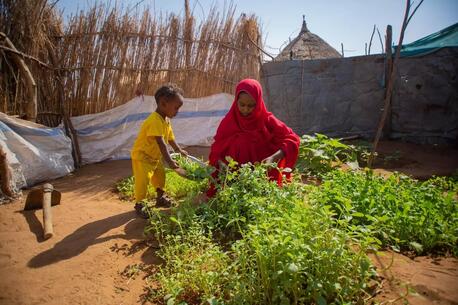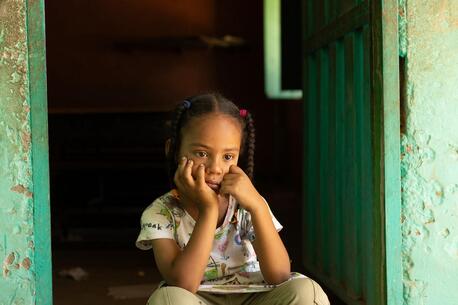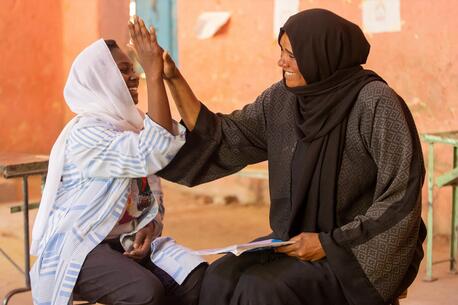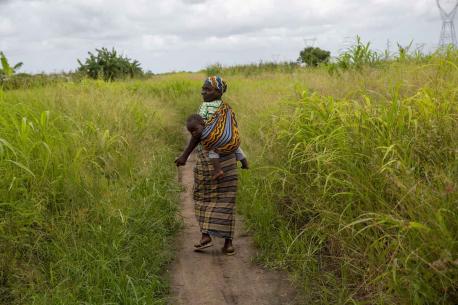
Earth Day in 2021
Earth Day 2021 dawns with the call to "Restore Earth" and support communities and areas that are disproportionately affected by environmental threats.
On April 22, 2021, as we mark the 51st anniversary of the first Earth Day, the global rollout of the COVID-19 vaccine offers hope that we will see the end of the pandemic. But for the world's children, significant damage has been done, and those who were already vulnerable due to poverty, water scarcity and environmental degradation are worse off than they were when the coronavirus emerged.
Upending the lives of children and families across the globe, COVID-19 has eroded children's health, safety and prospects by increasing poverty, exacerbating inequalities and jeopardizing their survival. UNICEF is working hard to halt that deterioration by leading the largest vaccine procurement and supply operation in history. By the end of 2021, the goal is to ensure delivery of 2 billion vaccine doses for more than 180 countries to help restart the world and rescue a generation of children from decades of COVID-caused setbacks.
When is Earth Day?
This year, Earth Day is April 22, 51 years after Americans from all walks of life rose up in protest over escalating environmental damage to the planet. Oil spills, rivers so polluted they caught fire, unfettered factory emissions and worsening smog galvanized students, academics and government officials who launched demonstrations nationwide to demand a better, healthier future for the environment and all who live in it.
Why do we celebrate Earth Day?
The climate is rapidly changing and humans are directly responsible. Climate change undermines many basic human rights, but especially those of the world’s children. Children and young people will inherit the impacts of climate change, which threaten the life-support systems that make the world habitable.
“Climate change has the potential to undermine all of their basic rights and indeed most of the gains made in child survival and development over the past 30 years,” said UNICEF Executive Director Henrietta Fore in her OpenLetter to the World’s Children on the 30th Anniversary of the Convention on the Rights of the Child. “There is perhaps no greater threat facing the rights of the next generation of children.”
- Climate-related disasters displace 22 million people every year
- Extreme weather events have more than doubled in the last 30 years and intensified, escalating droughts and flooding. Nearly a quarter of the world's farmable lands are degraded, destroying land and crops and compromising the food supply. The next generation of children will suffer disproportionately from hunger and malnutrition
- The growing number of cyclones, heat waves, floods and other extreme weather has added environmental threats to the list of stressors forcing migrants to flee their homes
- According to the International Organization for Migration, about 200 million people are expected to be displaced for environmental reasons by 2050; some estimates are as high as one billion
- As temperatures rise and water shortages become more acute, children pay the price. Over 1.4 billion people – including 450 million children – live in high or extremely high water vulnerability areas, where communities must depend on surface water, unsafe water or water that can take more than 30 minutes to collect
The world’s water crisis is not simply coming. It is here, and climate change will only make it worse, — UNICEF Executive Director Henrietta Fore
“The world’s water crisis is not simply coming,” said UNICEF Executive Director Henrietta Fore upon publication of a March 2021 UNICEF report. “It is here, and climate change will only make it worse.”
The origins of Earth Day
Various people deserve credit for the founding of Earth Day. Morton S. Hilbert, an environmentalist and University of Michigan professor emeritus of public health, is one. In 1968, Hilbert and the U.S Public Health Service organized the Human Ecology Symposium to educate students about the environmental dangers to their health. That symposium helped catalyze a campaign Hilbert and a group of students pursued over the next two years to get what became the first Earth Day off the ground.
1969's Santa Barbara Oil Blowout, a huge oil spill that occurred off the coast of California, was what propelled then Wisconsin Senator Gaylord Nelson to take action. Inspired by the energy of the students anti-war movement, Nelson announced a teach-in on college campuses to the national media and enlisted Denis Hayes, a young activist, as organizer. The date was set for April 22 to coincide with students' spring break but once the plan was broadened to engage all Americans, the concept drew national attention as a groundswell began to form around the day.
Where does the 'Earth Day' name come from?
Once a wide range of organizations and faith-based groups came on board and national media picked up the developing story, what had begun as a teach-in turned into a national day of protest and was renamed Earth Day. For the first Earth Day, 20 million Americans — 10 percent of the U.S. population — took to the streets in hundreds of cities to protest the environmental damage already done and demand immediate action to safeguard the planet.
They got results:
After the first Earth Day on April 22, 1970, the U.S. government took significant measures to protect the environment. The Clean Air Act was passed and the Environmental Protection Agency was created that same year. The Clean Water Act followed in 1972, then the Endangered Species Act in 1973.
Why children are the most vulnerable
Today, over a billion children live in areas subject to devastating flooding, and 160 million live in areas plagued by drought. Both threaten their survival.
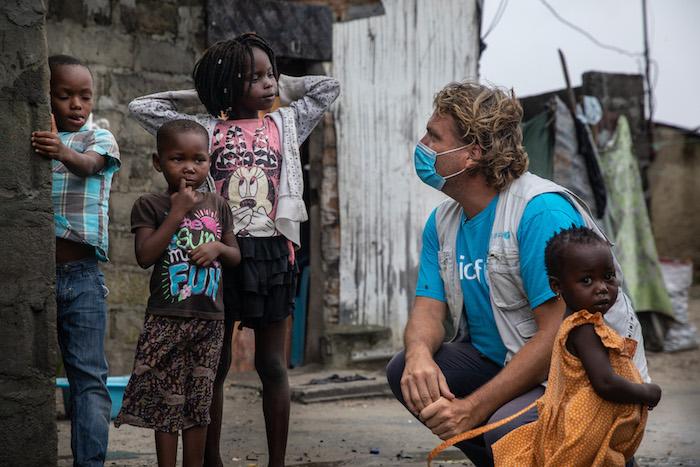
Above, Daniel Timme, UNICEF Mozambique's communications lead, visits with children in the Beira neighborhood of Praia Nova, after January 2021’s Cyclone Eloise struck the district, which is still struggling to recover from 2019's Cyclone Idai. High-speed winds and torrential rains disproportionately affect the city's poorer neighborhoods, where dwellings are mostly made out of corrugated metal and tarps. © UNICEF/UN0403969/Franco
Droughts cause crop failures and exacerbate food insecurity, which can trigger waves of migration and spikes in violence.
Pollution poses another danger to children’s health. Hundreds of millions of children breathe air that contains exceptionally toxic levels of pollution, making it a major contributing factor in the deaths of about 600,000 children under age 5. Given that COVID-19 attacks the respiratory system, children most exposed to indoor and outdoor air pollution will be particularly at risk.
There is no greater threat to children’s rights than the climate crisis. But children have UNICEF, working around the world to mitigate those threats, find new solutions and provide emergency relief.
Helping children survive extreme weather
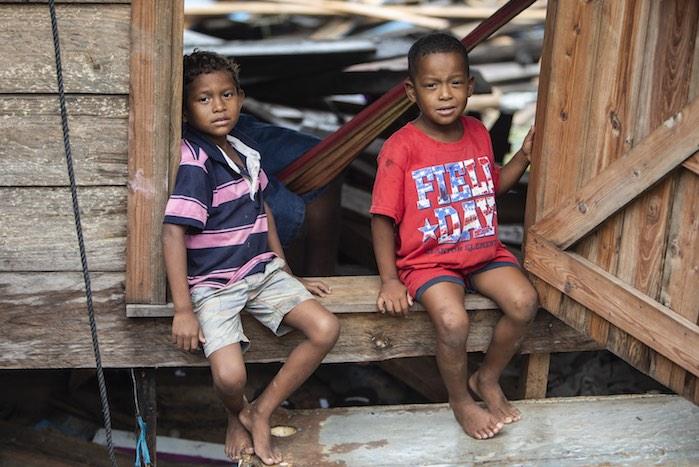
The two boys above sit amidst what's left of their neighborhood, El Muelle, after the Category 4 storm Hurricane Eta slammed into Nicaragua, forcing families to create shelters from the broken remains of their homes. © UNICEF/UN0360933
In November 2020, Category 4 Hurricanes Eta and Iota hit Nicaragua, Honduras and Guatemala within two weeks of each other. Nearly 9.3 million people — 3.5 of them children — were affected with thousands whose homes were destroyed or damaged driven into shelters. As of March 2021, over 1.8 million children need humanitarian aid, including thousands whose schools have been destroyed or heavily damaged and are waiting to resume learning.
In 2019, two major cyclones — Idai and Kenneth — hit Mozambique, causing flooding that upended the lives of 1.1 million children. In Beira, one of the areas hardest hit by Cyclone Idai, over 600 people were killed and nearly 240,000 homes destroyed when the superstorm made landfall in March. In early 2021, Cyclone Eloise hit the same area, causing severe flooding and threatening a population still recovering from Cyclone Idai. Tens of thousands of families lost their homes and widespread food insecurity caused further spikes in child malnutrition.
"It's heartbreaking," Daniel Timme, UNICEF Mozambique's communications lead, said during his visit to what was left of Beira's El Muelle neighborhood. "This is low ground, close to the sea and it's very dangerous.... We have to think of the population here and help them as much as we can."
Helping children learn through recycling
Prior to the COVID-19 pandemic, Côte d'Ivoire used an ingenious solution to one of its biggest environmental problems — plastic waste — to address another equally serious: 2 million children who had no place to learn due to rampant overcrowding in schools.
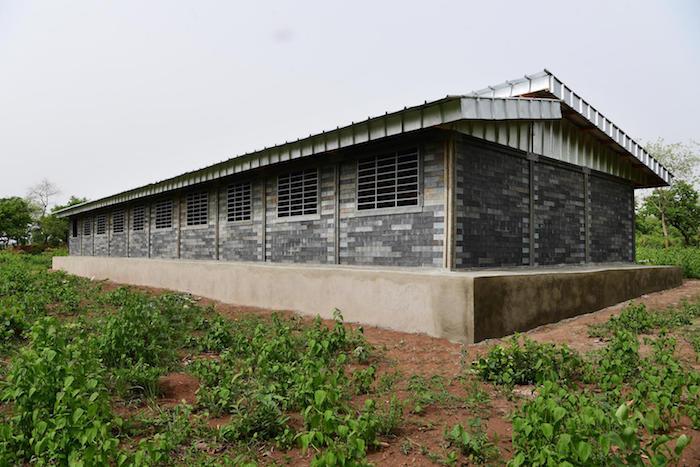
UNICEF helped build a school out of plastic bricks in Gouékolo in western Côte d'Ivoire. © UNICEF/UNI322873/Frank Dejongh
Côte d'Ivoire’s largest city, Abidjan, produces 288 tons of plastic waste every day. Unfortunately, most of it ends up in landfills and oceans. To turn an environmental blight into a resource, UNICEF worked with the Colombian company Conceptos Plasticos to build a factory that can transform plastic waste into bricks. UNICEF then used the recycled plastic bricks to build a model classroom at a school outside Abidjan in Gonzagueville, the first of many constructed since.
But over the past year, it became clear that it's not enough to build schools on grounds that aren't child-friendly. Because there were no bins where children could throw out their trash, the brand new schools ended up surrounded by garbage. Thus, the project entered a vital phase two with the launch of a “Green Initiatives” pilot.
Now, at Abidjan's Mamie Faitai school, recycled plastic cans have been refashioned as both trash receptacles and handwashing stations, where students have been practicing the safe hygiene so essential to fighting COVID-19. Tires were also turned into planters and cultivating vegetables added to the curriculum.
"It is gratifying for a child to feel responsible for a plant, to take care of it and to observe its growth," says one teacher. "These children are not used to taking care of plants at home because most of them don't have gardens."
By combining the "Green Initiative" project with constructing more schools from recycled plastic bricks, UNICEF Côte d'Ivoire and its partners are giving students essential education in environmental protection plus the chance to learn in healthy spaces.
What are the themes of Earth Day in 2021?
Climate change may not have caused COVID-19, but last spring United Nations (UN) environment chief, Inger Andersen, cited environmental degradation as a common underlying risk factor.
“Never before have so many opportunities existed for pathogens to pass from wild and domestic animals to people,” Andersen told The Guardian, explaining that 75% of all emerging infectious diseases come from wildlife. “Our continued erosion of wild spaces has brought us uncomfortably close to animals and plants that harbor diseases that can jump to humans.”
This Earth Day, young people can harness the spirit of the inaugural Earth Day by taking steps to head off future collisions with nature. It's a charge they are ideally equipped to lead.
One of the most visible is Greta Thunberg, who began her activism at age 8 after watching a documentary about climate change. From then on, she dedicated herself to reducing her carbon footprint and saving the planet.
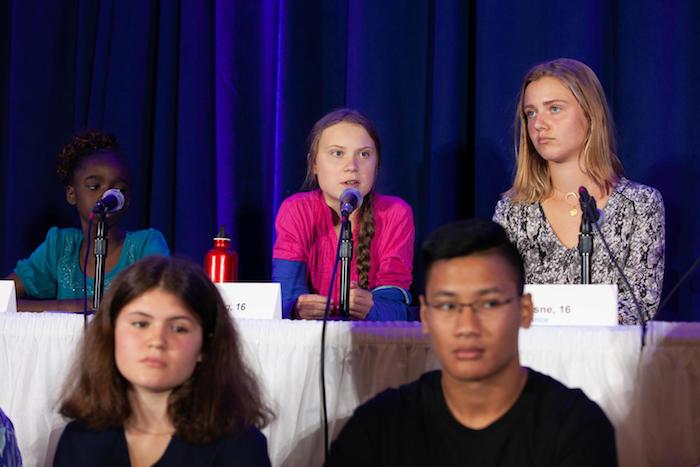
In August 2018, she skipped school to stand outside the Swedish Parliament with a sign that read “School Strike for Climate.” From that day forward she became a powerful force for climate action, rallying young people around the world to the cause.
On September 23, 2019, she and 15 other child petitioners went before the United Nations Committee on the Rights of the Child to call for global government action to address the climate crisis. The child petitioners, aged 8 to 17, asserted that UN Members' inaction violated their rights.
“Change needs to happen now if we are to avoid the worst consequences. The climate crisis is not just the weather. It means also, lack of food and lack of water, places that are unlivable and refugees because of it. It is scary,” said Thunberg.
In April 2020, she heralded Earth Day's 50th anniversary as the time to choose "a new way forward" and tackle the coronavirus and climate change at the same time. That same month, she donated a $100,000 award she received to UNICEF to fund soap, masks and gloves to protect children from the coronavirus pandemic.
UNICEF empowers and relies on young people like Thunberg to take their demands for a healthier planet straight to their elected officials. UNICEF also encourages children and young people to talk with their parents and other family members about the parallels between COVID-19 and climate change.
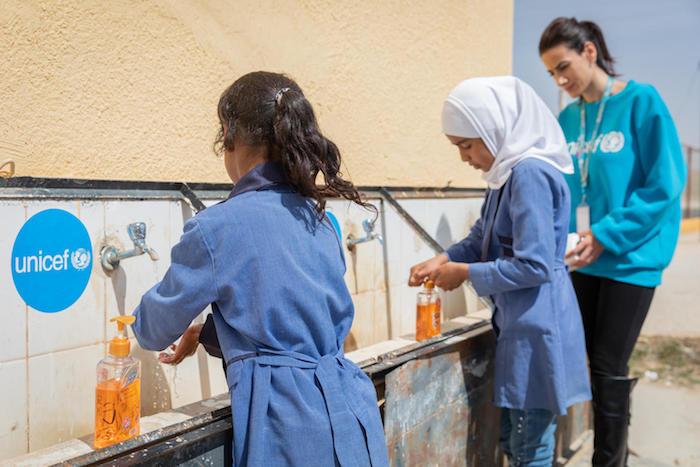
What can we do for Earth Day?
In honor of Earth Day 2021, you can make a difference by joining UNICEF USA and calling on the U.S. Government to protect children and young people from climate change by incorporating the following practices into U.S. foreign assistance programs and policies:
- Financing and enhancing the adaptation and resilience of services children depend upon most, such as water, health, education and nutrition
- Reducing emissions and pollution
- Developing child-centric climate change response plans
- Empowering children as agents of change by including them in decision-making on climate change programs and policy
Help UNICEF build a safer, more sustainable world for children.
Top photo: Maria, 32, carries her son home after a visit to a UNICEF health center in Mozambique’s Ndjenja resettlement camp. Since Mozambique was hit by three major cyclones and extreme drought and flooding, UNICEF is addressing the devastating impact of climate change on vulnerable families like Maria’s. © UNICEF/UNI310174/Prinsloo
